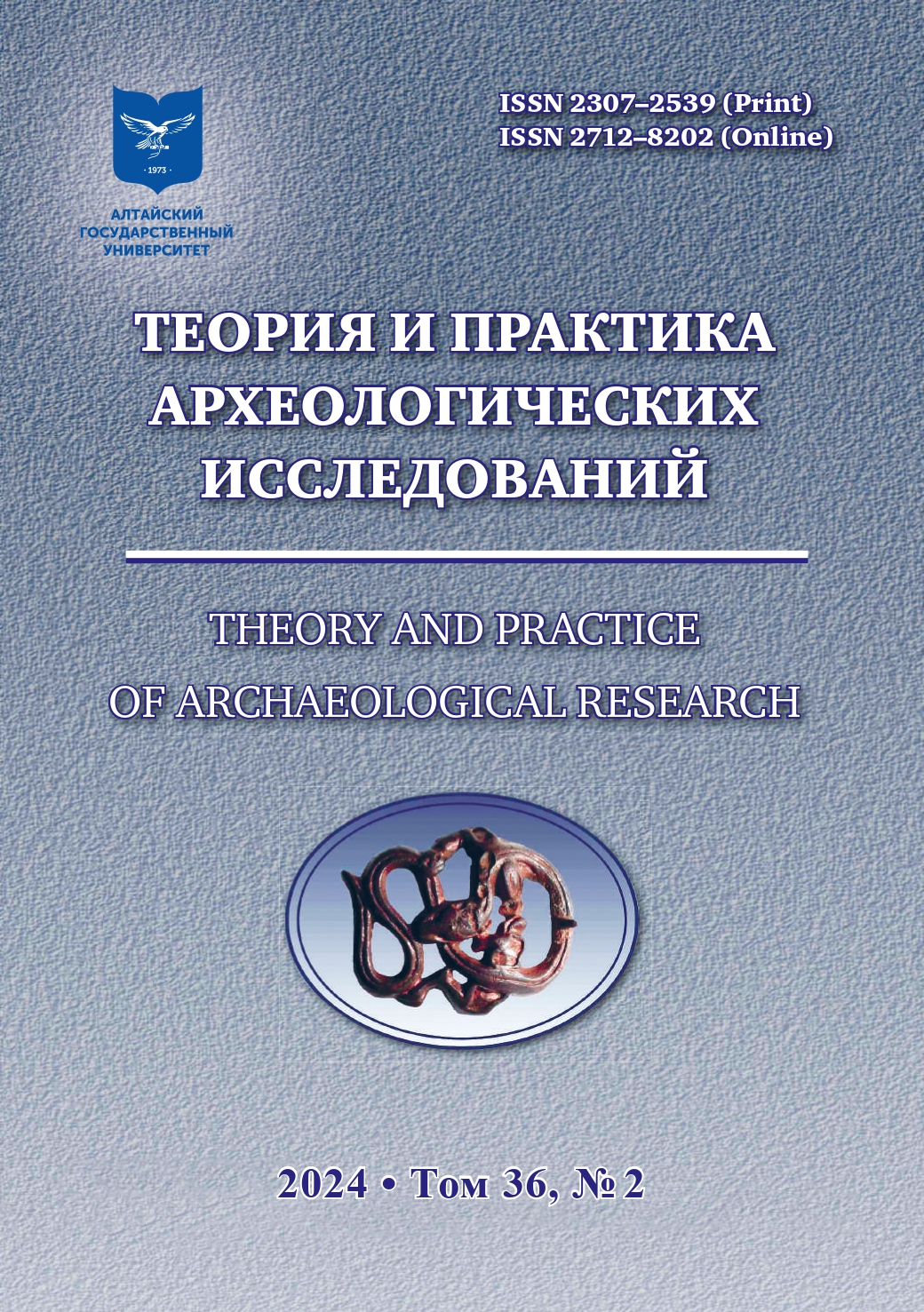ARCHAIC PERIOD ON THE SOUTHERN PERUVIAN COAST: FROM THE HUNTERS AND GATHERERS TO AGRICULTURALISTS
Abstract
The article examines the Middle Archaic Period (8–4,5 BP) on the southern coast of Peru (South America). The purpose of this work is to provide an overview of the history of research on the southern Peruvian coast, to highlight its features and international scope, and to demonstrate the fundamental role played by natural and climatic factors in the development of societies. The study also aims to illustrate the importance of an effective economy based on foraging and agriculture, as well as the key role of material culture and burial practices in growing societies. The conclusions drawn from this research and the published materials are still preliminary. They allow us to track a very interesting development in hunter-gatherer cultures. These cultures gradually increased the extraction of marine resources, settling in the lower streams of rivers and along the coast. This led to the development of initial agriculture, and later movement due to changes in climate, to the middle streams of rivers. It is important to note that this pattern (shift from maritime resources to agriculture) is different from the processes in the northern and central parts of the Peruvian coast. It can be considered as an original (local) model. To further explore this model, it will require not only acquiring additional archaeological evidence and dating, but also addressing a number of questions regarding the evolution of stone, wood, and bone technologies, burial practices, and the nature of agriculture (autochthonous, hybrid, or imported).
Downloads
Metrics
References
Vasiliev S.A., Berezkin Yu.E., Kozintsev A.G., Peiros I.I., Slobodin S.B., Tabarev A.V. Peopling of the New World: A Multidisciplinary Study. St. Petersburg : Nestor-Istoriya, 2015. 680 p. (In Russ.)
Dolgushin I.D., Tabarev A.V. On the 100th Anniversary of M. Uhle’s Works in Ecuador. Pervobytnaya arheologiya. Zhurnal mezhdisciplinarnyh issledovanij = Prehistoric Archaeology. Journal of Interdisciplinary Studies. 2019;2:98–109. (In Russ.)
Eloshkin G.A. Ritual Use of Obsidian in the Pre-Columbian Societies of the Southern Coast of Peru. In: Proceedings of the LXIII Russian (With International Participation) Archaeological and Ethnographic Conference of Students and Young Scientists. Novosibirsk : Izd-vo In-ta arheologii i etnografii SO RAN, 2023a. Pp. 255–257.
Eloshkin G.A. Man and the Desert: The Impact of the Aridian Conditions of the South Peruvian Coast on the Development of Pre-Colombanic Cultures. In: Ancient and Traditional Cultures in Interaction with the Environment: Problems of Historical Reconstruction: Materials of the II International Interdisciplinary Conference. Chelyabinsk : Izd-vo Chelyab. gos. un-ta, 2023b. Pp. 112–119. (In Russ.)
Eloshkin G.A. Early Studies of Archeological Cultures of the Southern coast of Peru (XIX — Early XX Century). In: Pacific Archaeology: Pacific Studies in Russian and Foreign Archeology: History, Current Stage and Development Prospects (Dedicated to the 300th Anniversary of the Russian Academy of Sciences). Vladivostok : Izd-vo Dal’nevostochnogo federal’nogo un-ta, 2024. Pp. 82–86. (In Russ.)
Eremeeva E.A. Variety of Burial Practices in the Southern Part of the Peruvian Coast (Chiribaya and Tiwanaku Cultures). In: Proceedings of the LXI Russian (With International Participation) Archaeological and Ethnographic Conference of Students and Young Scientists. Irkutsk : Izdatel’stvo IGU, 2021. Pp. 161–162. (In Russ.)
Ostrirova E.S. Maritime Foundations of Andean Civilization Theory in Modern Historiography. In: “Walls and Bridges” — III: History of the Emergence and Development of the Idea of Interdisciplinarity. Moscow : Akademicheskij proekt; Gaudeamus, 2015. Pp. 246–256. (In Russ.)
Tabarev A.V. Introduction to Archaeology of South America. Andes and the Pacific Coast: Textbook. Novosibirsk : Sibirskaya nauchnaya kniga, 2006. 244 p. (In Russ.)
Tabarev A.V., Gavrilina T.A. Origins of the Burial Traditions in the Ancient Cultures on the Pacific Coast of South America. Teoriya i praktika arheologicheskih issledovanij = Theory and Practice of Archaeological Research. 2017;1(17):167–180. (In Russ.)
Alday C., Garcia M.A., Alarcón C., Beresford-Jones D.G. The Use and Context of Fiber Plants During the Middle Preceramic: Evidence from La Yerba II and III, South Coast of Peru. Frontiers in Environmental Archaeology. 2023;2:1–21.
Benfer R.A. Frederic-Andre Engel (1908–2002). Andean Past. 2005;7:1–14.
Beresford-Jones D.G., Friesem D.E., Sturt F., Pullen A., Chauca G., Moat J., Gorriti M., Maita P.K., Joly D., Huaman O., Lane K.J., French C. Insights into Changing Coastlines, Environments and Marine Hunter-gatherer Lifestyles on the Pacific Coast of South America from the La Yerba II Shell Midden, Rio Ica Estuary, Peru. Quaternary Science Reviews. 2022;285:1–25.
Beresford-Jones D.G., Iparraguirre G.C., Lane K.J., Whaley O.Q., Moat J., Pullen A.G., Arce T.S., Garcia A.O., Cadwallader L., Rodriguez J., Joly D., French F.C. Revisitando la hipotesis de Frederic Engel: como las lomas determinan la distribucionarqueologica del preceramicoen la costa sur del Peru. Relaciones de la Sociedad Argentina de Antropologia. 2021a;46(2):383–413.
Beresford-Jones D.G., Pomeroy E., Alday C., Benfer R., Quilter J., O’Connell T.C., Lightfoot E. Diet and Lifestyle in the First Villages of the Middle Preceramic: Insights from Stable Isotope and Osteological Analyses of Human Remains from Paloma, Chilca I, La Yerba III, and Morro I. Latin American Antiquity. 2021b;32(4):741–759.
Beresford-Jones D.G., Pullen A.G., Chauca G. How Oases Born of Ocean Mists (Lomas) Shaped Mesolithic Human Ecology along the Arid Pacific Coast of Peru during the Middle Preceramic Period (ca. 8,000–5,000 BP). In: From Refugia to Oases: Living in Arid Environments from Prehistoric Times to the Present Day: XXXVIII rencontres internationa les a’archeologie et d’histoire d’Antibes. Antibes : APDCA, 2018a. Pp. 137–155.
Beresford-Jones D.G., Pullen A., Chauca G., Cadwallader L., Garcia M., Salvatierra I., Whaley O., Vasquez V., Arce S., Lane K., French C. Refining the Maritime Foundations of Andean Civilization: How Plant Fiber Technology Drove Social Complexity During the Preceramic Period. Journal of Archaeological Method and Theory. 2018b;25:393–425.
Conlee C.A. Nasca Culture Integration and Complexity: A Perspective from the Site of La Tiza. Journal of Anthropological Archaeology. 2014;35:234–247.
Eitel B., Hecht S., Machtle B., Schukraft G., Kadereit A., Wagner G.A., Kromer B., Unkel I., Reindel M. Geoarchaeological Evidence from Desert Loess in the Nazca–Palpa Region, Southern Peru: Palaeoenvironmental Changes and Their Impact on Pre-Columbian Cultures. Archeometry. 2005;47(1):137–158.
Engel F.-A. Un groupe humain datant de 5000 ans a Paracas, Perou. Journal de la Societe des americanistes. 1960;49:7–35.
Engel F.-A. Prehistoric Andean Ecology: Man, Settlement, and Environment in the Andes. Vol. 2: The Deep South. New York : Humanities Press, Hunter College, 1981. 155 p.
Gorbahn H. Pernil Alto: An Agricultural Village of the Middle Archaic Period in Southern Peru. Wiesbaden : Harrassowitz, 2020. 383 p.
Hrdlička A. Anthropological Work in Peru in 1913, with Notes on the Pathology of the Ancient Peruvians. Smithsonian Miscellaneous Collections. 1914;61(18):1–69.
Iparraguirre G.C., Glascock M.D., Rodríguez Morales J.A., Arce Torres S., Beresford-Jones D.G. El vidrio volcánico del litoral de Ica durante el Precerámico Medio (8000–5000 AP). In: Actas del Ⅴ Congreso Nacional de Arqueologia. Vol. Ⅱ. Lima : Ministerio de Cultura, 2020. Pp. 51–63.
Lanning E.P. A Pre-Agricultural Occupation on the Central Coast of Peru. American Antiquity. 1963;28(3):360–371.
Machtle B., Schittek K., Reindel M., Eitel B. Cambios paleoclimaticos y su influencia sobre el desarrollo cultural en el sur del area Central Andina. Revista de Arqueologia Americana. 2017;35:33–50.
Nakatsuka N., Lazaridis I., Barbieri C., Skoglund P., Rohland N., Mallick S., Posth C., Harkins-Kinkaid K., Ferry M., Harney E., Michel M., Stewardson K., Novak-Forst J., Capriles J.M., Durruty M.A., Alvarez K.A., Beresford-Jones D.G., Burger R., Cadwallader L., Fujita R., Isla J., Lau G., Aguirre C.L., LeBlanc S., Maldonado S.C., Meddens F., Messineo P.G., Culleton B.J., Harper T.K., Quilter J. et al. A Paleogenomic Reconstruction of the Deep Population History of the Andes. Cell. 2020;181(5):1131–1145.
Orefici G., Lancho Rojas J. The Nasca Area and Its Environment. In: The Ancient Nasca World: New Insights from Science and Archaeology. Cham : Springer International Publishing, 2016. Pp. 21–45.
Parsons M.H. Preceramic Subsistence on the Peruvian Coast. American Antiquity. 1970;35(3):292–304.
Quilter J. Late Preceramic Peru. Journal of World Prehistory. 1991;5(4):387–438.
Schittek K., Forbriger M., Machtle B., Schabitz F., Wennrich V., Reindel M., Eitel B. Holocene Environmental Changes in the Highlands of the Southern Peruvian Andes (14° S) and Their Impact on Pre-Columbian Cultures. Climate of the Past. 2015;11(1):27–44.
Uhle M. The Emeryville Shellmound. University of California Publication in American Archaeology and Ethnology. 1907;7(1):106.
Unkel I., Reindel M., Gorbahn H., Isla J., Kromer B., Sossna V. A Comprehensive Numerical Chronology for the Pre-Columbian Cultures of the Palpa Valleys, South Coast of Peru. Journal of Archaeological Science. 2012;39:2294–2303.
Copyright (c) 2024 Г.А. Елошкин

This work is licensed under a Creative Commons Attribution 4.0 International License.
Theory and Practice of Archaeological Research is a golden publisher, as we allow self-archiving, but most importantly we are fully transparent about your rights.
Authors may present and discuss their findings ahead of publication: at biological or scientific conferences, on preprint servers, in public databases, and in blogs, wikis, tweets, and other informal communication channels.
Theory and Practice of Archaeological Research allows authors to deposit manuscripts (currently under review or those for intended submission to ABS) in non-commercial, pre-print servers such as ArXiv.
Authors who publish with this journal agree to the following terms:
- Authors retain copyright and grant the journal right of first publication with the work simultaneously licensed under a Creative Commons Attribution License (CC BY 4.0) that allows others to share the work with an acknowledgement of the work's authorship and initial publication in this journal.
- Authors are able to enter into separate, additional contractual arrangements for the non-exclusive distribution of the journal's published version of the work (e.g., post it to an institutional repository or publish it in a book), with an acknowledgement of its initial publication in this journal.
- Authors are permitted and encouraged to post their work online (e.g., in institutional repositories or on their website) prior to and during the submission process, as it can lead to productive exchanges, as well as earlier and greater citation of published work (See The Effect of Open Access).








2.jpg)




